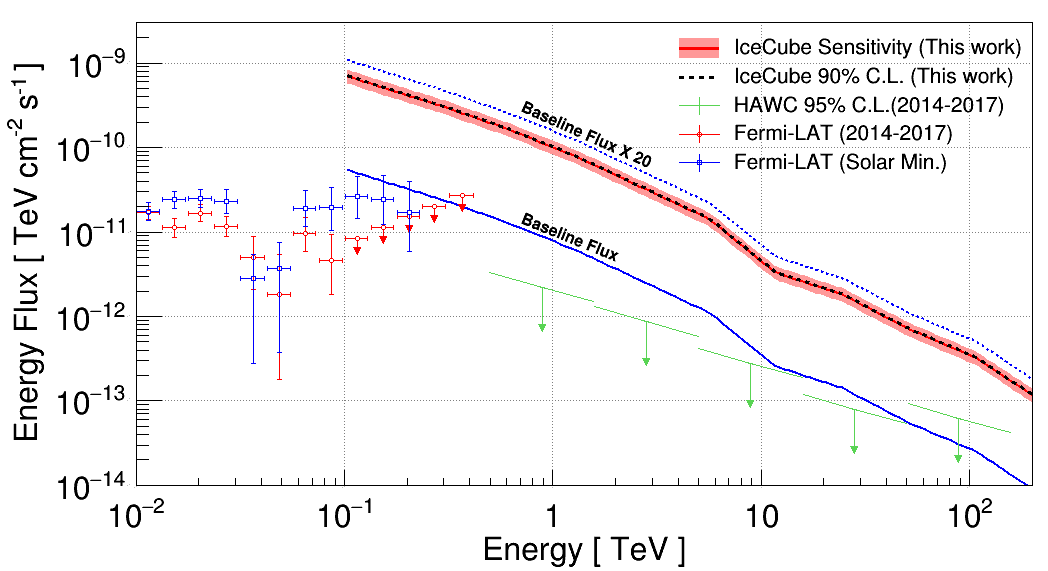Neutrinos are lightweight, elusive, and abundant particles; trillions stream through your body every second. Many of these neutrinos are produced when cosmic rays (energetic particles from outer space) interact with nuclei in Earth’s atmosphere, triggering a shower of secondary particles, including neutrinos. Specifically, these are known as atmospheric neutrinos.
But this process is not exclusive to Earth. The sun, the largest body in the solar system, also has an atmosphere. As cosmic rays propagate throughout space, they also enter the solar atmosphere and interact with nuclei there. Secondary showers in the solar atmosphere produce gamma rays and neutrinos that can be detected here on Earth. Recently, gamma rays from the sun were observed here by a space telescope, Fermi-LAT, but experimental studies have yet to show any neutrinos from solar cosmic ray interactions.
The IceCube Collaboration recently performed the first-ever experimental search for these so-called “solar atmospheric neutrinos.” Such a detection would have important implications for understanding solar magnetic fields and how cosmic rays propagate in the inner solar system, and it could even provide additional background to solar dark matter searches. But after investigating seven years of IceCube data, IceCube researchers did not detect any solar atmospheric neutrinos and so set an upper limit on the flux. Their results are outlined in a paper that was recently submitted to the Journal of Cosmology and Astroparticle Physics.

“One main difference between neutrinos produced in Earth’s atmosphere compared to the sun’s is the density of each atmosphere where the cosmic ray interactions occur,” says Seongjin In of Sungkyunkwan University in Seoul, South Korea, a lead on this analysis. Because of the different densities, we expect a greater flux for solar atmospheric neutrinos than Earth atmospheric neutrinos when looking at high-energy neutrinos—i.e., above 10^12 electronvolts (teravolt, or TeV) levels. Fortunately, IceCube is optimized to study these energy ranges.
In and his collaborators investigated IceCube data collected between 2010 and 2017. “We tracked the sun in the sky and selected IceCube data within a circular window of five degrees in angular distance from the center of the sun,” he says. “We then calculated a score for the data that reflects whether it could be explained with the background prediction only.” In other words, if the distribution of neutrino energy and the angular distance differed from what they expected, it could indicate that some neutrinos were produced in the sun’s atmosphere.
Ultimately, they found no evidence of solar atmospheric neutrinos; their observation was consistent with the background predictions. But In and his colleagues were able to set an upper limit on the solar atmospheric neutrino flux.

Importantly, this is the first experimental search for solar atmospheric neutrinos and the first experimental bound on its flux. And it certainly won’t be the last. There is already another search being carried out at Sungkyunkwan University by one of In’s colleagues.
After all, it’s possible that the researchers just weren’t looking at the right time. “If the neutrino flux modulates similarly to that of gamma rays, then the flux of solar atmospheric neutrinos may increase during the solar minimum,” says In, referring to the natural period of least solar activity in the sun’s 11-year cycle. “That means there might be a higher chance of observing solar atmospheric neutrino with data collected in the next solar minimum in 2020.”
There is still much to find out about solar atmospheric neutrinos, and IceCube will continue to be part of the search.
info “Searches for neutrinos from cosmic ray interactions in the Sun using seven years of IceCube data,” IceCube Collaboration: M. G. Aartsen et al., Journal of Cosmology and Astroparticle Physics 02 (2021) 025, iopscience.iop.org, arxiv.org/abs/1912.13135